 The Liquid-Cooled Computer
Page
The Liquid-Cooled Computer
Page
 The Liquid-Cooled Computer
Page
The Liquid-Cooled Computer
Page
I
just can't help
myself, I have
to fiddle!
I got interested in the liquid-cooling some years ago but the gear to
do it properly has only really been around for the last year or two, as
I type this.
A friend of mine works in a refrigerator factory, and so the wheels
were set into motion ....
I
did a lot
of research as to what I thought would work well and be reliable,
cost-effective, and easy to build. I looked at cooling with a device
similar to the Vaporchill system, Flourinert liquid-cooling,
conventional water-cooling, air-conditioning etc. One common problem
they all have is to stop condensation building up on the CPU and
surrounding metalwork, as the cooling effect can make those parts cold
enough to condense the moisture in the air.
After thinking about it for a while, I have decided to go for this sort
of cooling system - a refrigerator unit cools glycol down to as cold a
temperature as it can, a Silverprop water pump will pump it around the
plumbing, and the entire motherboard and video card will sit in either
a bath of non-conductive mineral oil. This will completely
eliminate all condensation problems.
It's weird, but all the ideas are based on completely conventional gear
& techniques.
I have a good ten litre supply of the non-conductive mineral oil,
courtesy of a friend in that industry, and so it's really just a matter
of a bit of contructing plumbing and so on to get it all done.
I will build it in a few stages -
Configuration #1
An Epox EP-8KDA3+ motherboard, with an Athlon64-3400 CPU, Geil DDR500
1gig ram, Albatron 6800GT video card, a Western Digital 120gig SATA
hard drive, and a Soundblaster Audigy. This will be an air-cooled
board, and basically just to make sure that everything runs reliably
before getting dunked in oil.
Configuration
#2
The whole motherboard will be submerged in the mineral oil. The
motherboard will have a SATA type connection to the hard
drive, as they can be run with a longer data cable than a regular ATA
one which is only 30cm verses the SATA's 100cm. From there, slow
increases in speed will be made until no more can be had from it
reliably.
2005, the year of frustration ...
Well, I tried.
I've given up any thoughts of trying to run the computer in a bath of liquid to keep it cool. As it turns out, it's hard enough to make just plain old water-cooling the CPU work. Here's the painful story of what I've tried.
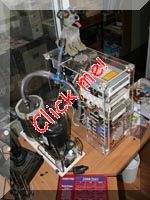 |
This was to be a
test-run of nearly all the bits that would go into the liquid bath. I
had high hopes, but as I found out the ability of the water chiller
tank to pass water wasn't anywhere near enough and so the entire
water-cooling system wasn't going to work at all. I didn't even get to
boot the computer up once to try it. Small children and animals were scared of it though, so that was satisfying at least. |
 |
I really wanted to try the water cooling though, so I ditched the water chiller unit and just added a large plastic container. I knew it'd eventually heat up the mass of water, but it'd take a few hours. And it really did work very well, with the CPU temps sitting well below that of the air-cooled testing. |
 |
The only hassle was
that I accidentally spilled some water onto the motherboard, and
although it'd run it wasn't stable and would crash for no reason. It
was perfectly stable with air-cooling, so I figured I must've done some
damage somehow. I replaced the Epox motherboard & CPU with a DFI one and Athlon X2 4200 but it just would not boot into Windows. Two weeks of effort by myself and a few other people were to no avail, so it had to be returned and an Epox 9NDA3J was purchased instead. Also new RAM and a case to be sure. |
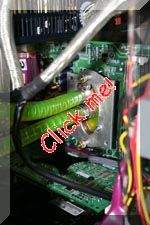 |
Under air-cooling,
the new system worked perfectly. However, the ram in the #2 slot soon
died for no apparent reason but I was trying to get the water-cooling
working so I left the ram problem for later. Here's the Cascade block mounted on the Epox motherboard. |
 |
To replace the large container of water I searched around at home and found in one of my bits & pieces of car parts a really neat little radiator. It's from the heater box assembly of the Toyota Altezza that I got the engine for my Sprinter from. |
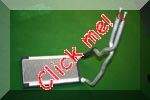 |
I had to make up some adaptors to get the 1/2" water pipes to fit the pipes on the radiator. It's made of lightweight aluminium and is of superb quality. I was really looking forwards to seeing how it would go. |
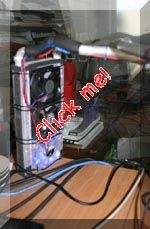 |
Digging around the computer spare parts box got me three 80mm fans. Not a permanent fit, but enough to test it all to see if it was going to work properly. |
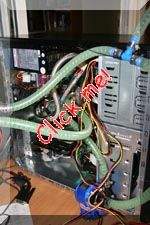 |
I used less
coolant/inhibitor in the water than before, to make sure I wasn't
gumming the system up somehow. Since it wasn't going to get anywhere
near sub-zero it only needed a little anyway to stop corrosion. I gave
all the pipes a nice, open radius so they wouldn't restrict the water
flow. But it just didn't work! The CPU temps were higher than that of air-cooling, and the only way I could keep the temps under control was to have a desktop fan blowing through the case. I took to several internet forums for help ... |
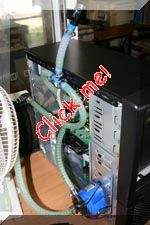 |
Despite the alloy
radiator looking like a very good thing, it was recommended to me that
I get a bigger one, so I did. I also got two large 120mm fans for it,
and made up an efficient cardboard shroud so that every bit of air from
the fans went through the radiator. I also took a bit more time thinking how to mount the pump and radiator, so at least the computer was sort-of portable. The piping was even straighter than before as well. |
 |
Well, guess what? Still no improvement! It still needed the desktop fan blowing through the case to keep things cool. So still asking for help from the forums I was asked to take some photos of the CPU block on the motherboard to see if the geeks could figure it out. |
 |
Here's the first
photo. You can see how the top of the Cascade mounting plate has a rough edge to it - That's because it's for a smaller CPU and to make it fit the big Athlon we had to TIG some small extensions onto the ends. They're ugly, but they work. |
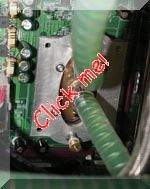 |
Same for the other
end of course. I mounted the CPU block that way so the water exits from the top, and that should encourage any air bubbles in there to leave. |
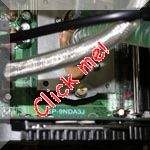 |
Another view of the
bottom. I'm not convinced the mounting system is the best way to go. |
So.
At the end of all this mucking around it still doesn't work. I'm pretty darn fed-up with the whole thing, but after some time to settle down I'm pretty sure the problem is that the Cascade block isn't seating on the CPU well enough, so the CPU is heating up because it can't transfer enough heat into the Cascade. When I get enthused enough again I'll give it another go, and this time make really sure the Cascade and CPU are fitted together as well as they can be. I have an alternate plan to clamp the Cascade down, so hopefully that'll help as well.
Oh, and the other good news (HA!) is that I also fried several sticks of expensive ram in the Epox motherboard. Fortunately all but one were replaced under warrantee, as it was thought that the ram was faulty. But as it turns out it's the motherboard that's killing them for some bizarre reason.
I've run out of steam for all
this, so when
I get around to trying it all again it'll be with a new motherboard,
new ram, and a new video card. For the moment it runs fine on the
single stick, but I guess that won't last.
Q:
So why do I choose to
overclock?
A: Because I like getting the most out of the gear, to see how far it
can go and so get the 'most bang for the buck'.
Q: Why don't I just buy a faster processor instead of all this mucking
around?
A: Because I'd overclock that as well!
There's no such thing as a PC that's fast enough ..... ;)
Back
to the computer page.